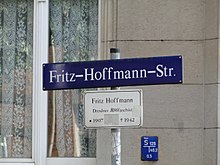Fritz Hoffmann (resistance fighter)
Fritz Hoffmann (born April 24, 1907 in Dresden ; † June 12, 1942 in Berlin-Plötzensee ) was a Dresden worker functionary and resistance fighter against National Socialism .
Life
As a 14-year-old Hoffmann joined the Socialist Workers' Youth . Shortly afterwards he began an apprenticeship as a carpenter. After a brief membership in the Syndicalist-Anarchist Youth of Germany , he joined the KPD at the age of 17 .
In the Oppellvorstadt , later called the “Hechtviertel”, he ran the KPD street cell “Hansa”. Together with a friend, he bought a small carpenter's workshop in 1929. This was used, among other things, to produce banners and posters, but also for gatherings. Since he had not registered a business, he was sentenced to 20 days in prison in 1932. In addition to his work in the KPD, he was also active in the proletarian free-thinker movement and, together with Rudi Lattner, in the singing department of the Friends of Nature opposition “ Rotsport ”. He sang as 2nd tenor in the mountaineering choir of the United Climbing Department ("Red Mountaineers"), which was directed by Kurt Schlosser .
In 1933, even after the seizure of power , they printed numerous leaflets in the fight against the growing fascism. From Czechoslovakia they brought illegal newspapers and magazines such as Die Rote Fahne and the Arbeiter Illustrierte Zeitung across the border to Dresden. On March 7, 1934, a large wave of arrests took place in the Hechtviertel, of which Fritz Hoffmann was also a victim. After a year of pre-trial detention, he was sentenced to two years and ten months in prison, among other things, for “illegal border work”, which he served in Zwickau-Osterstein . After his release he continued the struggle in illegality. He contacted the group around Fritz Schulze and Karl Stein . Fritz Hoffmann married in 1940.
In January 1941 he was arrested again and sentenced to death by the People's Court after 14 months of pre- trial detention. On June 12, 1942, he was executed by guillotine in Berlin-Plötzensee prison. His symbolic grave is on the Heidefriedhof in Dresden.
Commemoration
Since February 8, 1956, Radebeuler Strasse in the Scheunenhof district in the Leipzig suburb in Dresden has been called Fritz-Hoffmann-Strasse. Hoffmann's curriculum vitae is part of the biographical collection of the Association of Victims of the Nazi Regime , which is kept in the Federal Archives .
literature
- Fritz Hoffmann . In: Museum for the History of the City of Dresden: Biographical notes on Dresdner Strasse and squares that recall personalities from the labor movement, the anti-fascist resistance struggle and the socialist rebuilding . Dresden 1976, p. 40.
- Fritz Hoffmann . In: Museum für Stadtgeschichte, Alfred Werner (arr.): They fought and died for the coming law. Brief biographies of Dresden workers' functionaries and resistance fighters II . Meißner Druckhaus, Dresden 1963, pp. 55–58.
Individual evidence
- ^ Sächsischer Bergsteigerchor Kurt Schlosser Dresden eV: … and don't forget to work!
- ↑ Fight the human right. Life pictures and last letters from anti-fascist resistance fighters . Dietz, Berlin 1958, p. 659.
- ↑ Association of Victims of the Nazi regime, acts DY 55 / V 278/6/726
| personal data | |
|---|---|
| SURNAME | Hoffmann, Fritz |
| BRIEF DESCRIPTION | German worker functionary and resistance fighter against National Socialism |
| DATE OF BIRTH | April 24, 1907 |
| PLACE OF BIRTH | Dresden |
| DATE OF DEATH | June 12, 1942 |
| Place of death | Berlin-Plötzensee |

